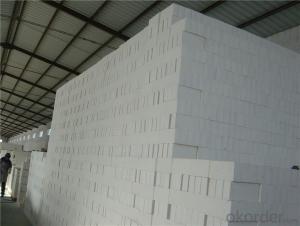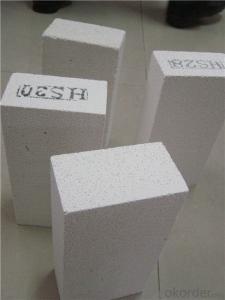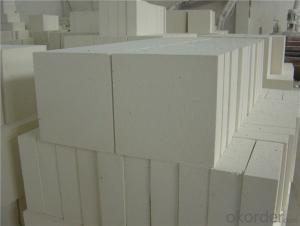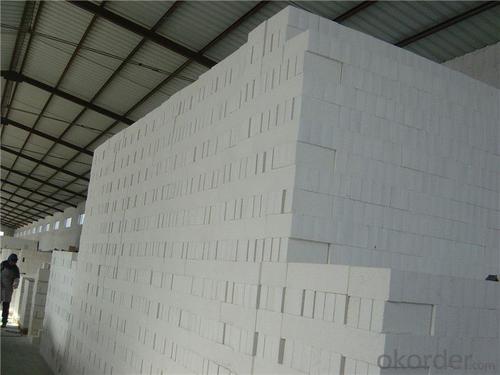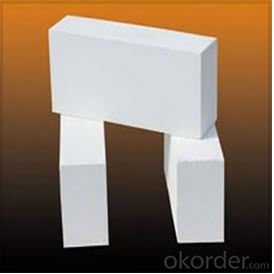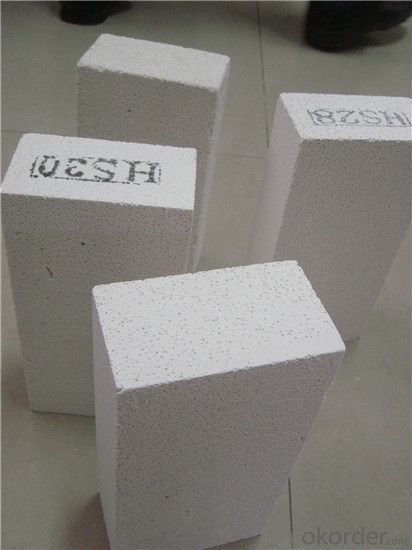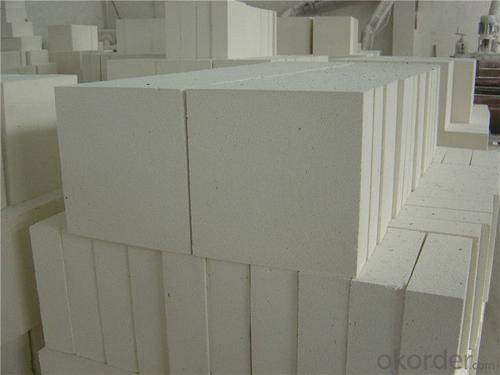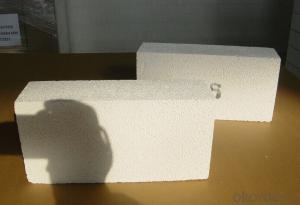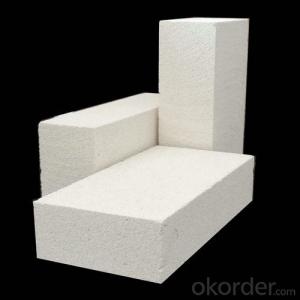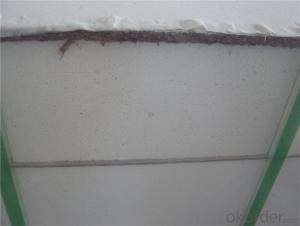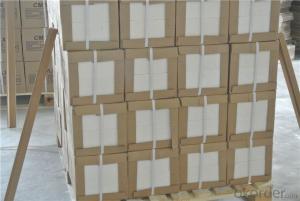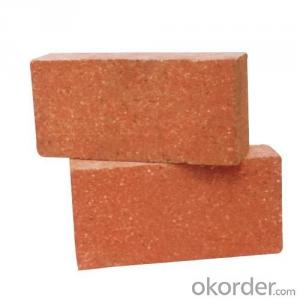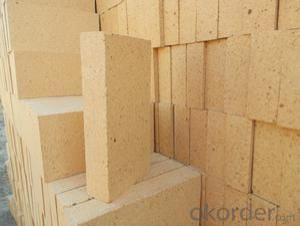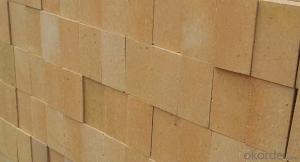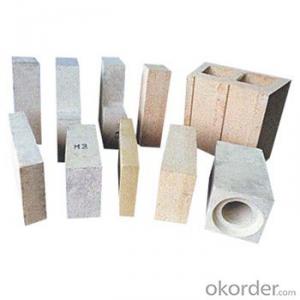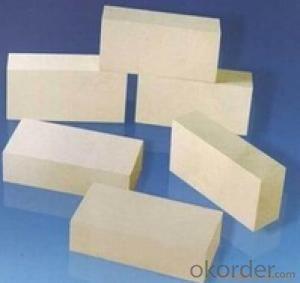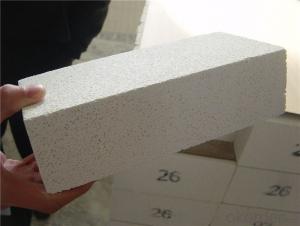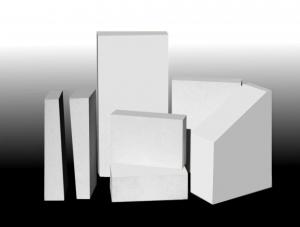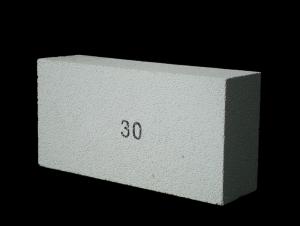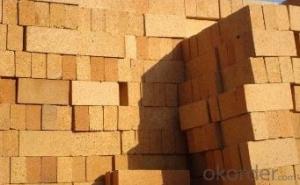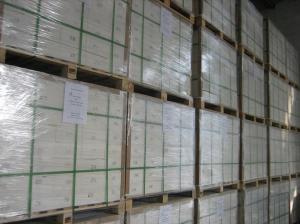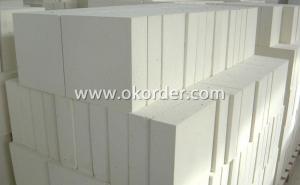Insulating Fire Brick - B-Series Lightweight Thermal Fireclay Insulation Brick
- Loading Port:
- Shanghai
- Payment Terms:
- TT OR LC
- Min Order Qty:
- 1 m.t.
- Supply Capability:
- 1000 m.t./month
OKorder Service Pledge
OKorder Financial Service
You Might Also Like
Thermal Insulation Fire Clay Brick
Refractory brick is a block of refractory ceramic material used in lining furnaces, kilns, fireboxes, and fireplaces.
We provide high quality Refractory Fire Bricks that are used on wide range in the various industries like Cement, Glass and Steel. Refractory Fire Bricks are provided as per the quantity and specifications required by the customers. We provide an extensive range of Refractory Fire Bricks at reasonable prices that depend upon the quantity ordered.
Application
Insulating Fire Brick are used for the lining of converter, alternating current arc furnace, direct Current arc furnace and the ladle slag line, etc.
Company Advantage
(1)Long Insulating Fire Brick manufacture history: 25 years manufacturer
(2)Advanced equipment
(3)Diversification of production standards: ISO ANSI FEPA JIS ASTM
(4)Flexible payment: T/T L/C D/P D/A
(5)Professional marketing team and after-sale service
Insulating Fire Brick main feature:
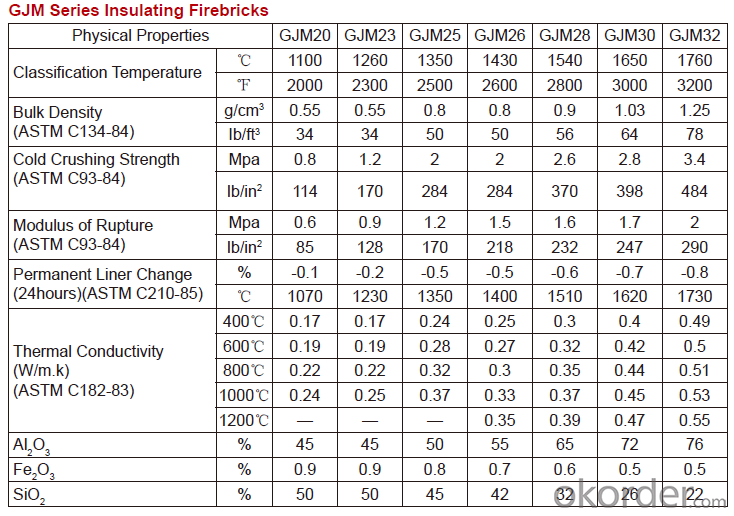
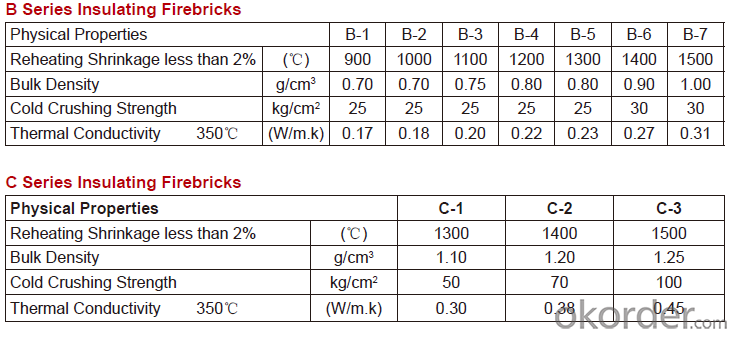
Equipment
1 unit of Ceramic Abrasive (SG Abrasive) pilot production line
2 units of Compact grain Abrasive pilot production lines
1 unit of high-end coated abrasives (abrasive cloth) production line
2 units of Boron Carbide production lines
3 large flexible crushing and sieving lines for grit production lines
6 units of 5000KVA-10000KVA dumping type electric arc furnaces for Brown Fused Alumina fusion
Q1 What’s the transport method?
A1 FCL delivery goods with wooden pallet or wooden case by sea; If LCL delivery, must with wooden case; Sometimes need open top, flat rack or bulk cargo.
Q2 What’s the required payment term?
A2 Generally 30% TT as the prepayment, 70% TT before delivery. If need, 100% Irrevocable Letter of Credit or negotiation.
Q3 Which country are our products exported to?
A3 Apart from entire Chinese market, the US, Russia, Japan, Korea, Australia and some Southeast Asian Nations.
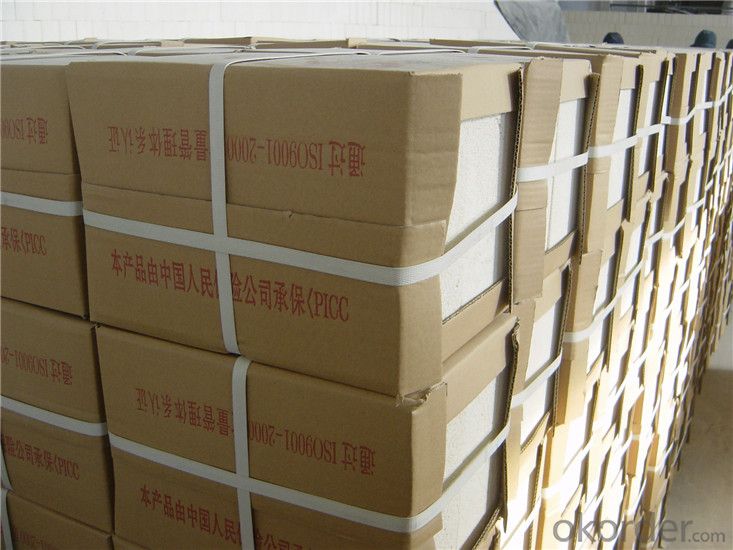
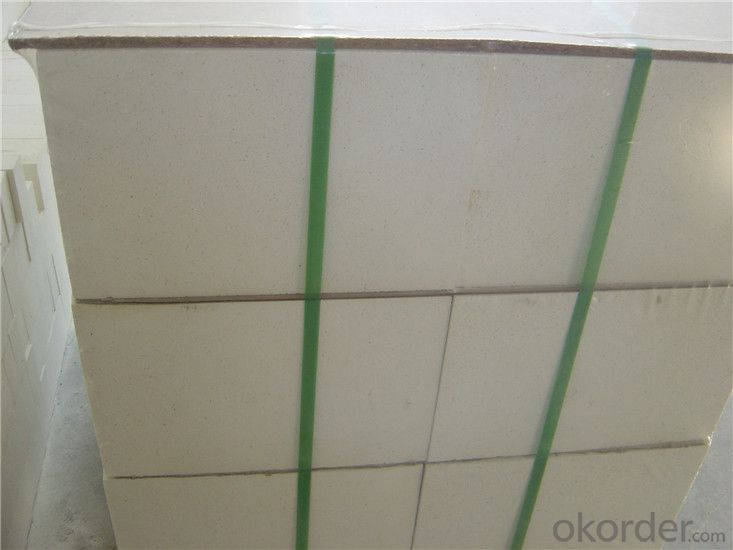
- Q: Are insulating fire bricks resistant to flame penetration?
- Yes, insulating fire bricks are resistant to flame penetration. Insulating fire bricks are made from materials that have high melting points and excellent thermal insulation properties. They are designed to withstand high temperatures and can resist flame penetration. These bricks are often used in applications where there is a need for insulation and protection against heat, such as in furnaces, kilns, and fireplaces. The composition and structure of insulating fire bricks make them highly resistant to flame penetration, allowing them to effectively contain and control the spread of fire.
- Q: Can insulating fire bricks be used as a refractory material?
- Yes, insulating fire bricks can be used as a refractory material. Insulating fire bricks are specifically designed to withstand high temperatures and thermal shock, making them suitable for applications that require heat insulation and refractory properties. They have low thermal conductivity, which helps to reduce heat loss and conserve energy. Insulating fire bricks are commonly used in various industries, including steel, glass, ceramics, and petrochemicals, where they are used as lining materials in furnaces, kilns, ovens, and other high-temperature equipment. Their ability to withstand extreme temperatures, coupled with their insulating properties, makes them an excellent choice for refractory applications.
- Q: Can insulating fire bricks be used in high-velocity gas flow applications?
- Insulating fire bricks are suitable for high-velocity gas flow applications due to their excellent thermal insulation properties, low thermal conductivity, and high resistance to temperature fluctuations. These characteristics make them appropriate for use in various high-temperature environments, including those with high-velocity gas flow. When subjected to high-velocity gas flow, insulating fire bricks maintain their structural integrity and insulation properties, effectively providing thermal insulation and protection. They find frequent application in kilns, furnaces, boilers, and other industrial equipment where high-velocity gas flow is present. However, it is essential to consider the specific requirements and characteristics of the gas flow in the given application. Parameters such as temperature, pressure, and chemical composition of the gas must be considered to ensure the compatibility and endurance of the insulating fire bricks. In conclusion, insulating fire bricks can be utilized in high-velocity gas flow applications due to their thermal insulation properties and resistance to temperature fluctuations. Nevertheless, it is crucial to carefully evaluate the specific requirements and characteristics of the gas flow to guarantee proper compatibility and performance.
- Q: Can insulating fire bricks be used as insulation in walls and roofs?
- Insulation in walls and roofs can be achieved by utilizing insulating fire bricks. These bricks are constructed from lightweight materials that possess exceptional thermal insulation properties. Their thermal conductivity is low, allowing them to effectively minimize heat transfer through walls and roofs. Consequently, they are a fitting selection for enhancing energy efficiency and insulating buildings. Furthermore, insulating fire bricks are both long-lasting and fire-resistant, rendering them a secure choice for insulation. Nevertheless, it is crucial to acknowledge that these bricks are typically employed in high-temperature environments such as furnaces and kilns. Thus, they might not be the most economical or practical option for all wall and roof insulation requirements. In terms of cost, installation ease, and overall performance, other insulation materials specifically designed for building applications may be more appropriate.
- Q: Can insulating fire bricks be cut or shaped as needed?
- Yes, insulating fire bricks can be cut or shaped as needed. They are typically made from lightweight materials such as ceramic fibers, which can be easily cut using a saw or other cutting tools. Additionally, they can be shaped using a knife or sandpaper to achieve the desired form.
- Q: Are insulating fire bricks resistant to ammonia gas?
- Insulating fire bricks, in general, lack resistance against ammonia gas. Although these bricks are engineered to endure elevated temperatures and offer thermal insulation, they are commonly constructed from lightweight refractory materials, like clay or silica, which are not particularly resilient to corrosive substances such as ammonia gas. Over time, ammonia gas can react with these materials and result in deterioration or harm to the bricks. Consequently, if you require fire bricks for an environment containing ammonia gas, it is advisable to opt for specially designed acid-resistant or chemical-resistant bricks that can endure the corrosive impact of ammonia gas.
- Q: Can insulating fire bricks be used in chimneys and flues?
- Insulating fire bricks are specifically designed for high-temperature applications and are often used in furnaces, kilns, and other industrial settings. While they do possess excellent insulating properties, they may not be the best choice for chimneys and flues in residential or commercial buildings. The main reason for this is that insulating fire bricks are not as durable and heat-resistant as other materials specifically designed for chimney and flue construction. They may crack or break when exposed to the extreme heat and rapid temperature changes that occur in chimneys. Additionally, these bricks are not typically designed to withstand the corrosive effects of flue gases, which can lead to their degradation over time. When it comes to chimneys and flues, it is generally recommended to use materials such as clay flue liners, stainless steel, or refractory bricks that are specifically manufactured for these applications. These materials are better suited to handle the high temperatures, corrosive gases, and rapid thermal expansion and contraction that occur in chimneys. It is important to consult with a professional chimney or flue specialist who can advise on the appropriate materials to use based on the specific requirements and conditions of your chimney or flue system.
- Q: What is the water absorption of insulating fire bricks?
- The water absorption of insulating fire bricks is typically low, ranging from 5% to 10%.
- Q: Can insulating fire bricks be used in reheating furnaces?
- Reheating furnaces can indeed utilize insulating fire bricks. These bricks are specifically designed to possess exceptional thermal insulation properties, rendering them ideal for applications requiring high temperatures, such as reheating furnaces. Due to their low thermal conductivity, these bricks can effectively retain and reflect heat, leading to energy conservation and enhanced heating efficiency. Furthermore, their lightweight nature and resistance to thermal shock allow them to endure rapid temperature fluctuations commonly encountered in reheating furnaces. In summary, insulating fire bricks offer a suitable option for insulating and lining the walls of reheating furnaces, ensuring efficient heat preservation and consistent temperatures throughout the furnace.
- Q: Can insulating fire bricks be used in rotary kilns?
- Yes, insulating fire bricks can be used in rotary kilns. Insulating fire bricks are designed to have low thermal conductivity, which means they are able to withstand high temperatures while minimizing heat loss. This makes them suitable for use in rotary kilns, which are used in various industries for processes such as calcination, sintering, and roasting. By using insulating fire bricks in rotary kilns, the heat generated inside the kiln can be effectively contained, leading to greater energy efficiency and cost savings. Additionally, the insulating properties of these bricks help to reduce the temperature on the outer surface of the kiln, making it safer for operators to work around the equipment. Overall, insulating fire bricks are a suitable option for rotary kilns, providing excellent thermal insulation and contributing to the overall performance and longevity of the kiln.
Send your message to us
Insulating Fire Brick - B-Series Lightweight Thermal Fireclay Insulation Brick
- Loading Port:
- Shanghai
- Payment Terms:
- TT OR LC
- Min Order Qty:
- 1 m.t.
- Supply Capability:
- 1000 m.t./month
OKorder Service Pledge
OKorder Financial Service
Similar products
Hot products
Hot Searches
Related keywords
